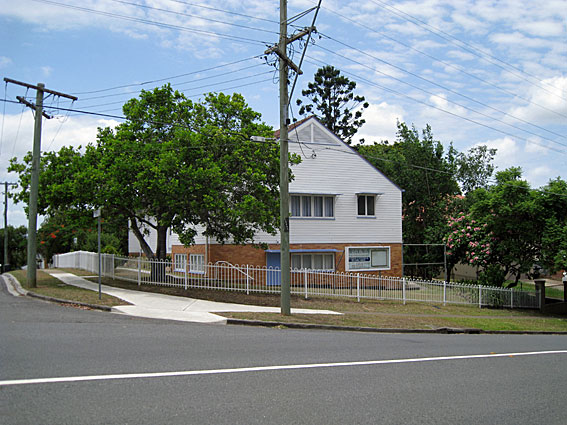
The Christadelphian Ecclesia Hall, Wellers Hill
[Photograph by Geoffrey Cox (January 2013)]

The Christadelphian Ecclesia Hall, Wellers Hill
[Photograph by Geoffrey Cox (January 2013)]
Historical and Technical Documentation by Geoffrey Cox
© OHTA 2012, 2013 (last updated January 2013)
The Christadelphian Ecclesia Hall at Wellers Hill was built originally as the Presbyterian Church, Wellers Hill.1 The congregation joined the Uniting Church in 1977, and the building was subsequently sold to the Christadelphians.
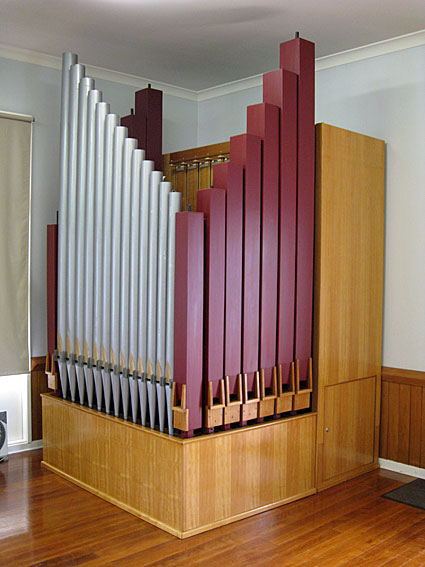
The organ in the Christadelphian Ecclesia Hall, Wellers Hill
[Photograph by Geoffrey Cox (January 2013)]
The organ now at this location incorporates the pipework and other components of the 2-rank extension organ originally built in 1957 by Charles Dirksen for the Church of Jesus Christ of Latter-Day Saints, Camp Hill. The Camp Hill Church was opened in August 1957, and the organ was installed in time for the opening.2
Alongside the two-rank extension organ for the Mormon chapel, Toowoomba (June 1957), this was one of Dirksen's earliest instruments for Mormon churches. Dirksen is reported to have earned a massive commission to build 14 similar instruments for Mormon churches throughout Australia.3 Apart from this one and the one for Toowoomba, the others in Queensland were his two-rank extension organs for the Mormon chapel at Chermside (1958) and a four-rank extension organ for the Mormon chapel at Kangaroo Point (1958). Dirksen's other extension organs in Queensland were all of four ranks: St Luke's Anglican Church, Ekibin (1957), the Presbyterian Church, Wynnum (1960) and Emmanuel College, St Lucia (1961).
The pipework of the Camp Hill instrument was entirely enclosed, apart from the bottom octave of the Principal rank and the lowest 14 Bourdon pipes.
| GREAT Bourdon A Violin Diapason Stop Diapason Principal Flute Twelfth Fifteenth Piccolo SWELL Bourdon Violin Diapason Stop Diapason Principal Flute Nasard Fifteenth Piccolo PEDAL Sub Bass Violin Diapason Stopped Flute Quint Principal Flute NO COUPLERS |
16 8 8 4 4 2-2/3 2 1 16 8 8 4 4 2-2/3 2 1 16 8 8 5-1/3 4 4 |
A B A B A B B B A B A B A A B B A B A A B A |
Tremulant
Compass: 61/32
Direct electric action
Detached stop-key console
Balanced swell pedal.4
The specification was essentially identical with that of the Toowoomba instrument, with the same derivation of stops on the Swell and the Great in each case, apart from the difference between the Twelfth 2-2/3ft and Nasard 2-2/3ft.
The Dirksen organ was removed from Camp Hill and installed in St Mary's Catholic Church, Bardon, in 1979 by H.W. Jarrott of Brisbane.5 It was removed from Bardon by Jarrott in the mid 1980s and sold to Ray Smith, who remains the owner of the present instrument. Dirksen's pipework and other components were incorporated by Ray Smith (with some assistance from Jarrott) into the present instrument at the Christadelphian Hall, Wellers Hill in 2000-2002.6
Ray Smith, a cabinet maker by trade, worked from 1956 onwards on a contract basis for the Brisbane organ builder, H.W. Jarrott, building most of Jarrott's consoles over a period of some forty years, 1960-2000. This is the second instrument built by Smith himself, the first one being completed at his own residence at Camp Hill in 1971.
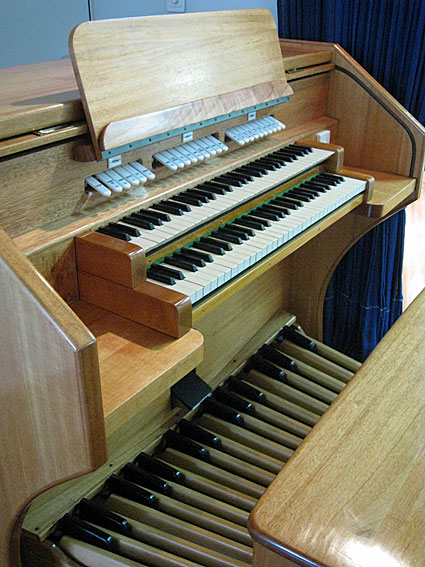
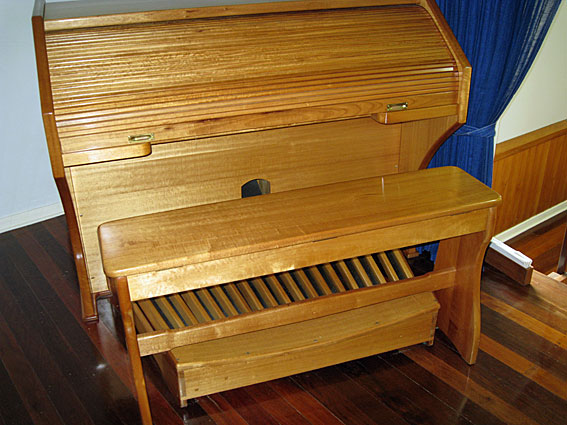
The Console at Wellers Hill
[Photographs by Geoffrey Cox (January 2013)]
The new roll-top console incorporates Dirksen's 32-note pedalboard and two secondhand Whitehouse keyboards obtained from H.W. Jarrott. The two ranks of the Dirksen instrument now comprise the Great and Pedal of the present organ, extended in much the same configuration as Dirksen intended. The arrangement of the façade pipes (bottom octave of the Open Diapason and the bottom octave of the Bourdon pipes on either side) remain essentially as Dirksen had them.
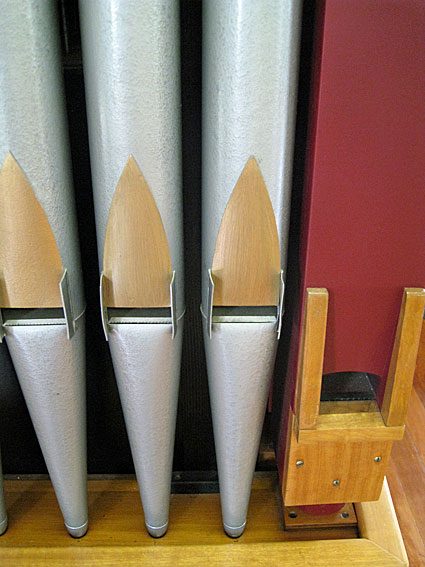
Dirksen's Open Diapason and Pedal Bourdon pipes in the façade
[Photograph by Geoffrey Cox (January 2013)]
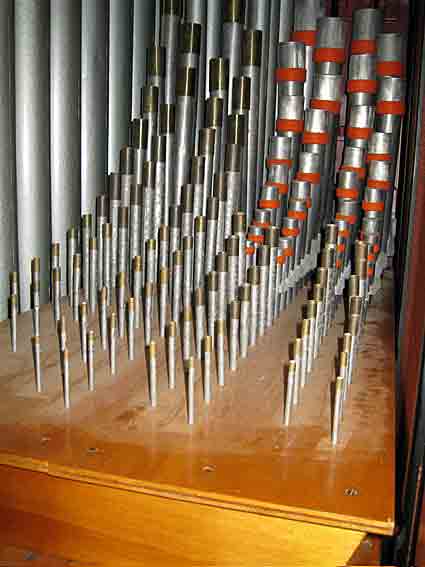
The two-rank Great Organ
configured as Dirksen arranged it
[Photograph by Geoffrey Cox (January 2013)]
The Swell pipework was all purchased from David Cahill of Warwick, and derives from several sources. The Principal 4ft was originally the Swell Violin Diapason 8ft (Ten.C) in the Whitehouse organ at the Methodist Church, Nundah (1924), while the other Swell pipework originated from Adelaide and Lithgow.7
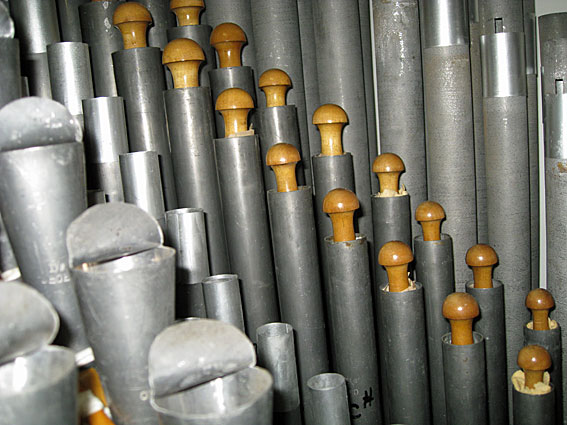
The Swell pipework at Wellers Hill
[Photograph by Geoffrey Cox (January 2013)]
| GREAT Sub bass Open Diapason Stopped Diapason Principal Flute Nasard Fifteenth Piccolo Octavin SWELL Gedect Viola Principal Oboe PEDAL Harmonic Bass Bourdon Principal Bass Flute Flute COUPLERS Swell to Great Swell to Pedal Swell Super to Great Swell Sub to Great Swell Super Swell Sub |
16 8 8 4 4 2-2/3 2 2 1 8 8 4 8 32 16 8 8 4 |
A B A B A A B A B A A B A A |
[gvd bass] [Whitehouse, 1924, from Methodist Church, Nundah] |
Tremulant (general)
Electric action
Detached stop-key console
Balanced swell pedal
Radiating concave pedalboard
Compass: 61/32.8
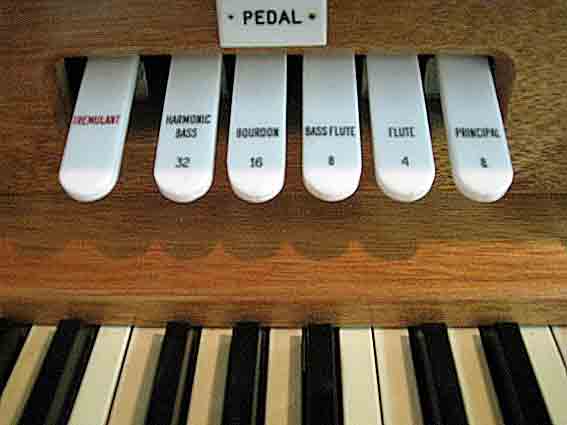
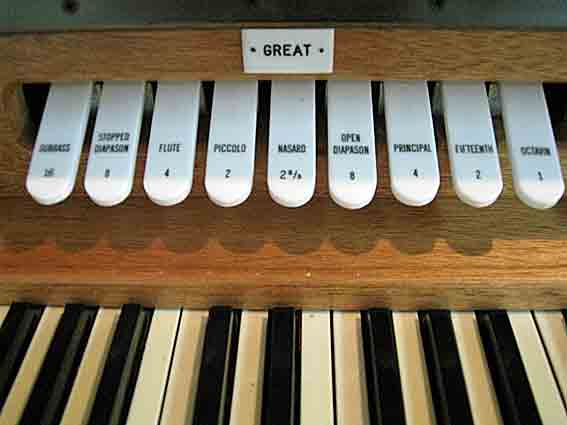
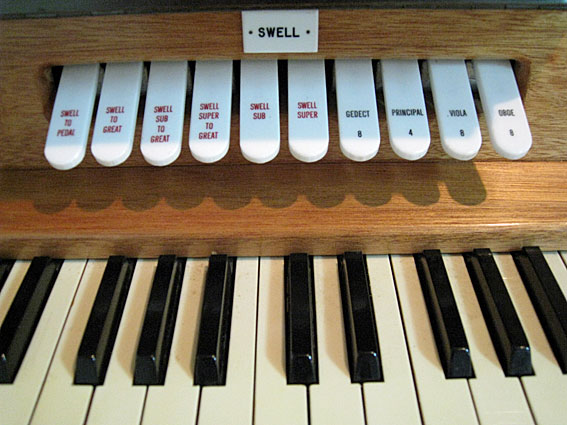
Stop-key details
(Photographs by Geoffrey Cox (January 2013)]
______________________________________________________________________
1 Wellers Hill Presbyterian Church, Our Venture in Faith (Brisbane, n.d.).
2 Date supplied by Mrs A. Campbell (organist at Camp Hill) from church records, c.1974.
3 Personal communication to G. Cox from John Spall (employee of Dirksen), c.1974.
4 Specification noted by G. Cox at Camp Hill, February 1974; Compass supplied by Ray Smith, 2004.
5 Personal communications to G. Cox from Jim Clinch and H.W. Jarrott, c.1980.
6 Personal communication to G. Cox from Ray Smith, January 2004.
7 Personal communication to G. Cox from Ray Smith, January 2004.
8 Specification noted by G. Cox, January 2004.